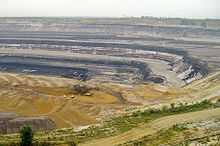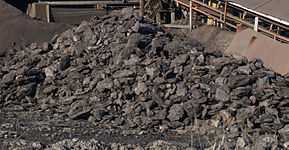Lignite
Lignite, often referred to as brown coal, is a soft brown combustible sedimentary rock that is formed from naturally compressed peat. It is considered the lowest rank of coal due to its relatively low heat content. It is mined in China, Bulgaria, Greece, Germany, Kosovo, Poland, Serbia, Russia, Turkey, the United States, Canada, India, Australia and many other parts of Europe and it is used almost exclusively as a fuel for steam-electric power generation, but is also mined for its germanium content in China. 26.3% of Germany's electricity comes from lignite power plants,[1] while in Greece lignite provides about 50% of its power needs.
Characteristics

Lignite is brownish-black in color and has a carbon content of around 25-35%, a high inherent moisture content sometimes as high as 66%, and an ash content ranging from 6% to 19% compared with 6% to 12% for bituminous coal.[2]

The energy content of lignite ranges from 10 – 20 MJ/kg (9–17 million BTU per short ton) on a moist, mineral-matter-free basis. The energy content of lignite consumed in the United States averages 15 MJ/kg (13 million BTU/ton), on the as-received basis (i.e., containing both inherent moisture and mineral matter). The energy content of lignite consumed in Victoria, Australia averages 8.4 MJ/kg (6.5 million BTU/ton).
Lignite has a high content of volatile matter which makes it easier to convert into gas and liquid petroleum products than higher ranking coals. Unfortunately its high moisture content and susceptibility to spontaneous combustion can cause problems in transportation and storage. It is now known that efficient processes that remove latent moisture locked within the structure of brown coal will relegate the risk of spontaneous combustion to the same level as black coal, will transform the calorific value of brown coal to a black coal equivalent fuel while significantly reducing the emissions profile of 'densified' brown coal to a level similar to or better than most black coals.[3]
Uses
Because of its low energy density and typically high moisture content, brown coal is inefficient to transport and is not traded extensively on the world market compared with higher coal grades. It is often burned in power stations near the mines, such as in Australia's Latrobe Valley and Luminant's Monticello plant in Texas. Primarily because of latent high moisture content and low energy density of brown coal, carbon dioxide emissions from traditional brown-coal-fired plants are generally much higher per megawatt generated than for comparable black-coal plants, with the world's highest-emitting being Hazelwood Power Station, Victoria.[4] The operation of traditional brown-coal plants, particularly in combination with strip mining, can be politically contentious due to environmental concerns.[5][6]
Reaction with quaternary amine forms a product called amine-treated lignite (ATL), which is used in drilling mud to reduce fluid loss during drilling.
Geology

Lignite begins as an accumulation of partially decayed plant material, or peat. Burial by other sediments results in increasing temperature, depending on the local geothermal gradient and tectonic setting, and increasing pressure. This causes compaction of the material and loss of some of the water and volatile matter (primarily methane and carbon dioxide). This process, called coalification, concentrates the carbon content, and thus the heat content, of the material. Deeper burial and the passage of time result in further expulsion of moisture and volatile matter, eventually transforming the material into higher rank coals such as bituminous and anthracite coal.[7]
Lignite deposits are typically younger than higher rank coals, with the majority of them having formed during the Tertiary period.
Resources
The Latrobe Valley in the state of Victoria, Australia contains estimated reserves of some 65 billion tonnes of brown coal.[8] The deposit is equivalent to 25% of known world reserves. The coal seams are up to 100 metres thick, with multiple coal seams often giving virtually continuous brown coal thickness of up to 230 metres. Seams are covered by very little overburden (10 to 20 metres).[8]
Types
Lignite can be separated into two types. The first is xyloid lignite or fossil wood and the second form is the compact lignite or perfect lignite.
Although xyloid lignite may sometimes have the tenacity and the appearance of ordinary wood it can be seen that the combustible woody tissue has experienced a great modification. It is reducible to a fine powder by trituration and if submitted to the action of a weak solution of potash it yields a considerable quantity of Humic acid.[9]
Dark black lignite, or jet, is where the term 'jet black' originates.[10]
Production
| Country | 1970 | 1980 | 1990 | 2000 | 2001 | 2010 | 2013 |
|---|---|---|---|---|---|---|---|
| | 369.3 | 388.0 | 356.5 | 167.7 | 175.4 | 169 | 183 |
| | n.a. | n.a. | n.a. | n.a. | n.a. | 163 | n.a. |
| | 127.0 | 141.0 | 137.3 | – | – | – | – |
| | – | – | – | 86.4 | 83.2 | 76 | 73 |
| | 4.4 | 15.0 | 43.8 | 63.0 | 57.2 | 69 | 63 |
| | 24.2 | 32.9 | 46.0 | 65.0 | 67.8 | 67 | 63 |
| | 5.4 | 42.3 | 82.6 | 83.5 | 80.5 | 65 | 70 |
| | 8.1 | 23.2 | 51.7 | 63.3 | 67.0 | 56 | 54 |
| | 32.8 | 36.9 | 67.6 | 61.3 | 59.5 | 56 | 66 |
| | 67.0 | 87.0 | 71.0 | – | – | – | – |
| | – | – | – | 50.1 | 50.7 | 44 | 40 |
| | 26.0 | 43.0 | 60.0 | – | – | – | – |
| | – | – | – | 35.5 | 35.5 | – | – |
| | – | – | – | – | – | 37 | 40 |
| | 13.0 | 22.0 | 38.0 | 40.0 | 47.0 | n.a. | n.a. |
| | 14.1 | 27.1 | 33.5 | 17.9 | 29.8 | n.a. | n.a. |
| | 5.7 | 10.0 | 10.0 | 26.0 | 26.5 | n.a. | n.a. |
| | n.a. | n.a. | n.a. | 22.11 | n.a. | n.a. | 45 |
| Total | 804 | 1,028 | 1,214 | 877 | 895 | 1,042 | 6972 |
| Source: worldcoal.org – Coal Statistics[11] · 1particular source for India Y2000[12] · 2 Sum of top 10 producers only (n.a.) no data available, (–) country did not exist yet or does not exist anymore | |||||||
Gallery
-

Opencast mining Schleenhain in Saxony, Germany. The village of Heuersdorf will soon be swallowed up.
See also
- Bergius process
- Coal assay
- Energy value of coal
- Orders of magnitude (specific energy density)
- Fischer-Tropsch process
- Karrick process
- Leonardite
- List of CO2 emitted per million Joule of energy from various fuels
- Kemper Project
References
- ↑ "Renewables Take Top Share of German Power Supply in First". 2014-10-01. Retrieved 2015-03-08.
- ↑ Ghassemi, Abbas (2001). Handbook of Pollution Control and Waste Minimization. CRC Press. p. 434. ISBN 0-8247-0581-5.
- ↑ George, A.M.. State Electricity Victoria, Petrographic Report No 17. 1975; Perry, G.J and Allardice, D.J. Coal Resources Conference, NZ 1987 Proc.1, Sec. 4.. Paper R4.1
- ↑ "Hazelwood tops international list of dirty power stations". World Wide Fund for Nature Australia. Retrieved 2008-10-02.
- ↑ "The Greens Won't Line Up For Dirty Brown Coal In The Valley". Australian Greens Victoria. 2006-08-18. Retrieved 2007-06-28.
- ↑ "Greenpeace Germany Protests Brown Coal Power Stations". Environment News Service. 2004-05-28. Archived from the original on 2007-09-30. Retrieved 2007-06-28.
- ↑ Blatt, H., Middleton, G. and Murray, R. (1972). Origin of Sedimentary Rocks. Prentice-Hall Inc., New Jersey. ISBN 0-13-642702-2.
- ↑ 8.0 8.1 Department of Primary Industries, Victorian Government, Australia, ‘Victoria Australia: A Principle Brown Coal Province’ (Fact Sheet, Department of Primary Industries, July 2010).
- ↑ Mackie, Samuel Joseph (1861). The Geologist. Original from Harvard University: Reynolds. pp. 197–200.
- ↑ http://www.thefreedictionary.com/jet
- ↑ http://www.worldcoal.org/resources/coal-statistics/
- ↑ http://infochangeindia.org/environment/statistics/statewise-production-of-coal-and-lignite.html
External links
| Wikimedia Commons has media related to Lignite. |
- Geography in action - an Irish case study
- Photograph of lignite
- Coldry:Lignite Dewatering Process
- Why Brown Coal Should Stay in the Ground
- Victoria Australia Brown Coal Factsheet
- Australian mines atlas
| |||||||||||||||||||||


